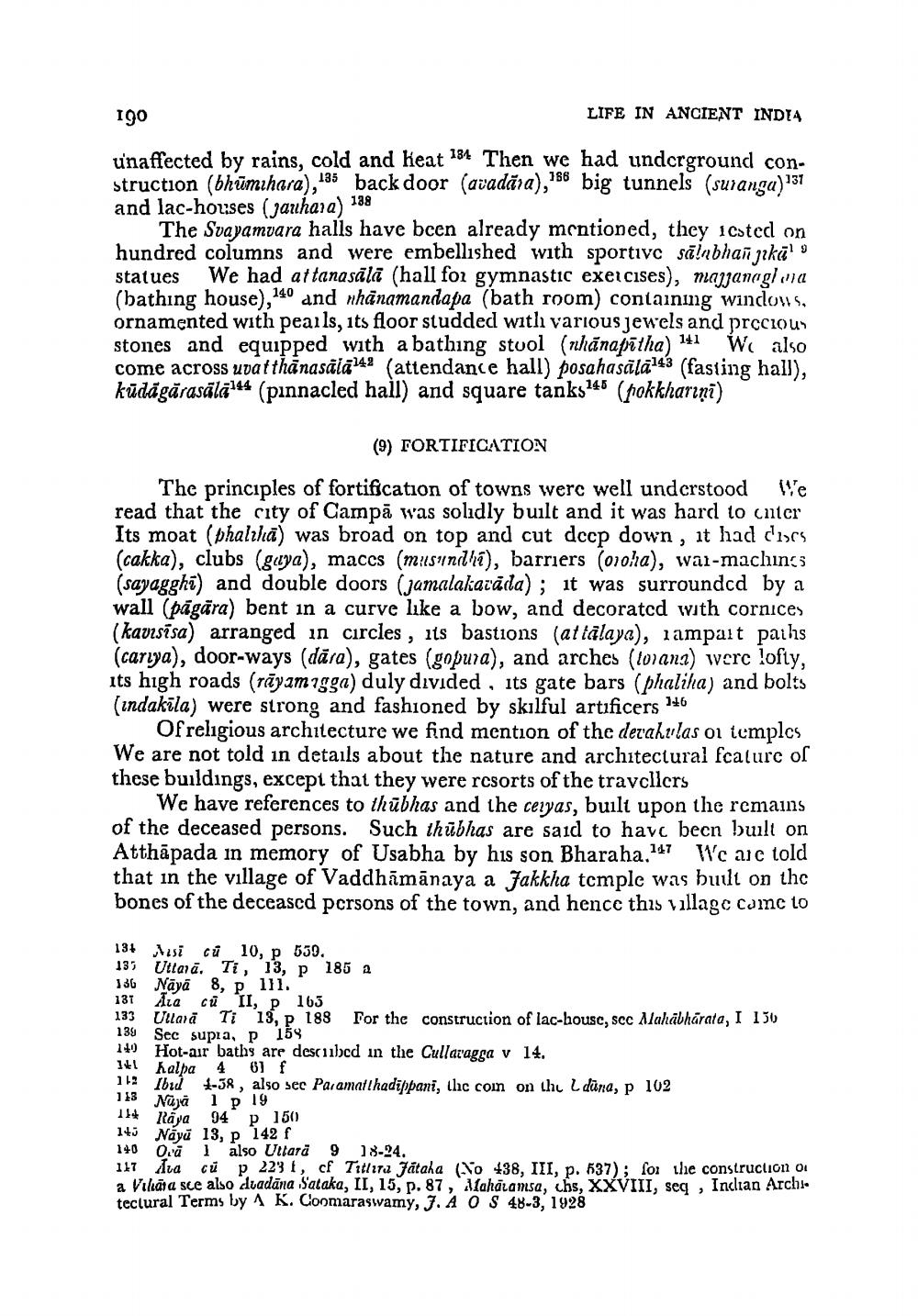________________
190
LIFE IN ANCIENT INDIA
unaffected by rains, cold and heat 134 Then we had underground construction (bhūmihara),135 back door (avadãra),186 big tunnels (suranga) 137 and lac-houses (Jauhara) 138
The Svayamvara halls have been already mentioned, they icsted on hundred columns and were embellished with sportivc sālnbhai jika 9 statues We had attanasālā (hall foi gymnastic exercises), majjanag'ma (bathing house),140 and whānamandapa (bath room) containing windows, ornamented with pearls, its floor studded with various jewels and precious stones and equipped with a bathing stool (nhānapitha) 141 We also come across uvatthānasalā142 (attendance hall) posahasālā143 (fasting hall), kūdāgārasālāł44 (pinnacled hall) and square tanks146 (fokkharıni)
(9) FORTIFICATION
The principles of fortification of towns were well understood We read that the city of Campā was solidly built and it was hard to cntcr Its moat (phalıhā) was broad on top and cut dccp down, it had discs (cakka), clubs (guya), maces (misundhi), barriers (oola), war-machin (sayagghî) and double doors (jamalakarāda); it was surrounded by a wall (pāgāra) bent in a curve like a bow, and decorated with cornices (kavisīsa) arranged in circles, its bastions (at talaya), iampait paths (cariya), door-ways (dāra), gates (gopura), and arches (wana) werc lofty, its high roads (rāyamagga) duly divided , its gate bars (phaliha) and bolts (indakila) were strong and fashioned by skilful artificers 146
Of religious architecture we find mention of the detahuilas oi templcs We are not told in details about the nature and architectural fcature of these buildings, except that they were resorts of the travcllcrs
We have references to thübhas and the ceryas, built upon the remains of the deceased persons. Such thūbhas are said to have been built on Atthāpada in memory of Usabha by his son Bharaha 147 W'caic told that in the village of Vaddhāmānaya a Jakkha temple was built on the bones of the deceased persons of the town, and hence this village came to
18+ si cứ 10, p 559, 133 Utlarā. Ti, 13, p 185 2 136 Nāyā 8, p. 111. 137 Aca cū II, p 163 133 Ullarā Ti 13, P 188 For the construction of lac-housc,scc Alahābharata, I 150 139 Sec supia, P 159
Hot-air baths are descuibed in the Cullaragga v 14. 141 kalpa 4 61 f 112 Ibid 1-38, also sec Paramatl hadippani, thic com on thu L dūna, p 102 113 Nūja 1 p 19 114 Raya 94 p 150 141 Náyū 13, p 142 f 140 Oral also Ultara 9 18-24. 117 Ava cū p 223 1, cf Titlita Fataha (No 438, III, p. 637); for the construction ou a Vulāra sce also duadāna Sataka, II, 15, p. 87, Alahāramsa, chs, XXVIII, seq , Indian Archie tectural Terms by ^ K. Coomaraswamy, J. AO S 48-3, 1928




